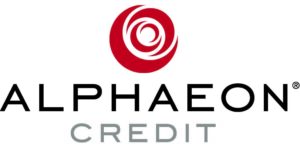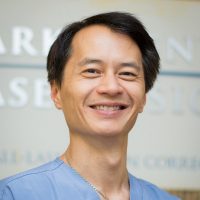Meet Dr. Chynn
Education

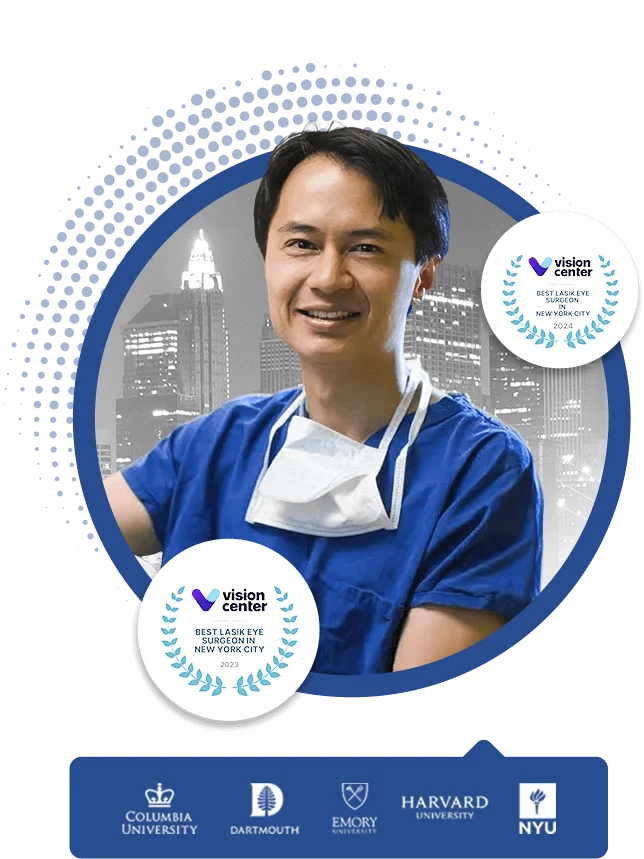
My Story
– Dr. Emil William Chynn
When I was a premed student at Dartmouth in the 1980s the only procedures were RK and AK. These are incisional procedures where the surgeon makes manual incisions to change the shape of your cornea. This technique was discovered by Dr. Filatov, an eye surgeon in Ukraine when he treated a child who fell off his bicycle, shattered his eyeglasses, and lacerated his cornea with many cuts. Fortunately each incision only went 99% through the cornea and didn’t perforate, or else the aqueous humor would have leaked out. Dr. Filatov decided to patch rather than sew the eye, since suturing always distorts the cornea and induces astigmatism. Miraculously, when the patch was removed, not only was his cornea intact–the child’s myopia had disappeared! I had followed the progress of refractive surgery myself since the 1970s, my interest was selfish back then–I was very nearsighted because I had the genetic predisposition from my parents. By the time I was at Dartmouth the older Russian technique had been supplanted by the American technique, that used a diamond blade.
These procedures were unpredictable and did not yield stable results.
In the 1980s, when I was at Columbia Medical School, two ophthalmologists invented laser vision correction by patenting the excimer laser, which is used in 99% of cases today. These surgeons were Stephen Trokel and Francis L’Esperrance. The original patent for the excimer laser was held by IBM, which had developed it in Armonk, NY for possible use to etch silicon wafers for computer circuit boards. This use didn’t pan out, but my two smart preceptors’ “use patent” to use this technology for eye surgery did. Thus was born a billion dollar industry!
Unfortunately, Drs. Trokel and L’Esperrance licensed their patents to competing companies. Dr. Trokel’s company became VISX, which is the market leader in refractive surgery in the US, with more procedures performed on the VISX platform than all other brands–combined. This is the market saying that most MDs feel the VISX laser is best (including myself, as I’ve used every laser, but own a VISX). Dr. L’Esperrance’s company was Summit, which was bought by Alcon, which never achieved more than a small market share, and whose laser got pulled off the market by FDA around 2009, so they bought another company and rebranded their laser.

I know a lot about the history of laser vision correction because I was there. Dr. L’Esperrance is the one who actually first trained me on an early Alcon laser. Both doctors inspired me to conduct applied science research, and I’ve got 2 US patents granted and 1 pending for new ophthalmology inventions.
Eventually these two competing companies engaged in “patent wars” after a long legal battle both companies were tired of litigation, so agreed to merge their patents into a “patent suite” and just collect royalties from the “end-users” (doctors like me!). This is why, even though I bought my VISX laser for $500,000 and own it, I have to pay a “click fee” every time I use the laser (which is about $250/ eye for low-def and $500/eye for Hi-Def). Because of this royalty/click fee the VISX laser is by far the most expensive laser on the market in the US to operate. But top surgeons in the US have stuck with this platform because we feel it’s the most robust. Of course, a surgeon choosing VISX will have to charge more, as his costs are more.
For example, I did over 1,000 LASIKs on the Nidek laser (with a $1,000 less cost basis) when I was just starting out working as a “shooter” for a discount “laser chain” up in Boston. While results were good, that laser didn’t have the ability to correct hyperopia, so we had to be overly conservative with our nomograms because we didn’t want overcorrection’s because we couldn’t go back in the other direction. Which lead to a lot of under-corrections and reoperations, which isn’t ideal.
In any case, during the end of my time at Columbia University’s College of Physicians and Surgeons, I’d decided to go into ophthalmology as my specialty of choice. This was a surprising coincidence, as it would make me a third-generation eye surgeon!
My grandfather grew up in China but fled to Hong Kong to escape communism. He eventually became a famous eye surgeon there and even served briefly as Minister of Health. My uncle has been a prominent retinal surgeon at Harvard for 30 years, with his own Retina Fellowship Program (it’s very prestigious to run a fellowship program, only 1% of surgeons continue on to subspecialize and complete a fellowship, which means you’ve been chosen to train the next generation of sub specialists in the country).
When I was applying for my ophthalmology residency I had my heart set on Harvard, which is the pinnacle of academics in the US. I spoke to the secretary in charge of handling applications during my interview, and she told me they had received 800 applications for 8 spots! Noticing my crestfallen look, she told me, “Cheer up–we narrow that down to ‘only’ 100 interviewees!”
Fortunately, I was accepted by Harvard, and started my residency there in 1993. Everyone there was brilliant, so it was an incredible environment to learn not only the latest surgical techniques, but to conduct research.As a resident, I published articles in the top 3 eye journals in the world (Ophthalmology, Archives of Ophthalmology, and American Journal of Ophthalmology), which I was very proud of.
In 1995, I performed my first RK and PRK procedures, and both patients saw 20/20. However, I was concerned about the manual nature of RK, and the pain and delayed recovery in PRK (the original type of laser vision correction, and the older form of surface ablation).
Two of the doctors at Harvard I had published clinical research with in Ophthalmology, Jon Talamo and Juan Carlos Abbad, invented LASEK. In LASEK, an alcohol solution is used to delaminate the epithelium or skin of the eye from the underlying cornea. This gentle, clean separation prevents the crushing of millions of epithelial cells that occurs in PRK, which is the cause of the pain and delayed healing after PRK.
Because I was very nearsighted and astigmatic my entire life (-7.50 -1.50 x 180 in both eyes), and had followed refractive surgery since RK in the 1970s, I was fascinated by the field. I decided to be a true expert in refractive surgery. The most famous refractive surgeon in the US is George Waring III. I got accepted into his fellowship program and was his Corneal Transplantation and Refractive Fellow from 1996-1997. Dr. Waring is the one who lead the group in the 1990s who conducted the FDA-sponsored national study called PERK that proved RK isn’t stable. This is why no competent surgeon in the world performs RK anymore.
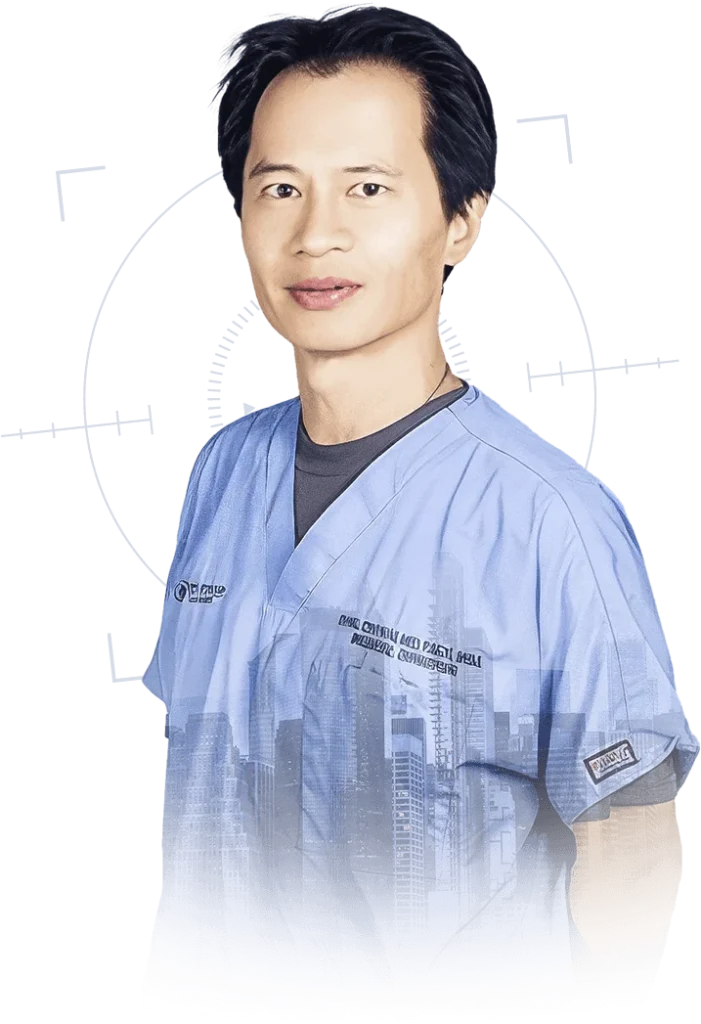
I performed my first LASIK in 1996 under George Waring, and was ecstatic when the patient wound up seeing 20/15, or better than “perfect” 20/20 vision. However, I was petrified when the microkeratome was cutting the flap, as that’s a step we surgeons need to leave under the control of a machine, and I’d seen patients blinded permanently during that cutting step.
From 1997-2000 I worked as a “shooter” at one centre in Boston and two other centers in NYC, including TLC, which at that time was the largest chain in the world, listed on Nasdaq, and with a market cap of $1 billion. Although I got incredible surgical experience and performed about 5,000 LASIKs, including my record of 56 in one day, I grew disillusioned by the “factory” nature of their business.

Laser chains and discount laser centers always have non-MDs (either ODs who don’t go to medical school and aren’t trained in surgery, or even less qualified “techs”) do the preop testing and postop exams. Then they have a MD come in 1-2 days per week to do the surgery, he has to rely on the testing done by the non-MD on a different day, as those are the numbers entered into the laser to correct the Rx. While this is the most cost-effective way to run a laser centre (because you’re only paying for an MD 4-8 days out of the month) it’s not the best way to deliver optimal patient care.
I realized that any surgeon who relies on a non-surgeon’s data for surgery is not playing it safe. So I quit my “shooter” jobs shortly thereafter.
In 1999 I had my own LASIK performed. At the time I was the first LASIK surgeon in NYC to have the procedure myself, my former Chief Resident at Harvard, Roberto Pineda MD performed it. At the time I had a live weekly AM talk radio show in NYC where people could call in and ask LASIK questions. So we simulcast the surgery from the OR in Boston to my audience in NYC. That’s the first time this was done!
My surgery went well and I got rid of my myopia and astigmatism and got to 20/20. However I had dry eyes and have to take tears daily, because my corneal nerves got cut by cutting the LASIK flap. I also had bad night glare, also caused by the LASIK flap. In 2000 I became a partner in a LASIK centre on West 14th St. We were a very small operation, which was good, because in 2001 9/11 happened, which destroyed the laser vision correction market in the Tri-State area for a year.
I was actually the very first MD to arrive at WTC after the towers were hit. How this happened is an interesting story. In 1993 I was an intern at St. Vincent’s hospital when WTC was attacked the first time. As the closest Level III trauma centre to WTC, all the doctors weren’t allowed to leave, to handle the flood of victims. That lesson stayed with me. So when I saw the twin towers burning from my apartment building I fed my dog, Hershey, walked him, put together an emergency first aid kit, put on my rollerblades, and headed downtown.
I missed having them come down on my head by 10 minutes. I met some nurses and EMTs down there and we thought we were at the wrong corner. It took us a while to figure out that the 100′ pile of rubble we were next to had once been a 1000 foot tower. We set up the first triage centre, the first ER, and later, once it became apparent we would be seeing mostly fatalities, not casualties–the first morgue.
I volunteered at WTC for the first 10 days, until FEMA had things finally under control, and we could go home. I wound up with asthma from working on “the pile”.
Publications
Dr. Chynn has published extensively, both nationally and internationally. He is first author on over a dozen peer-reviewed publications, including all three leading ophthalmic journals in the US.
Dr. Chynn has published over 100 articles in non-peer reviewed literature, including many in Ophthalmology Times, the #1 popular journal in ophthalmology (according to annual readership and sales figures, provided by OT).
These articles report on the latest advances in LASIK and the more advanced LASEK and epi-LASEK (epi-LASIK) laser vision correction techniques and are widely read by eye surgeons across the US – especially those who are unable to attend the prominent meetings covered (the American Academy of Ophthalmology, the American Society of Cataract and Refractive Surgeons, the Association for Research in Vision and Ophthalmology).
Dr. Chynn’s Articles About Laser Vision Correction
- Hyperopic LASIK
- Hyperopic PRK
- Re-treatment one year after photo refractive keratectomy (PRK) for myopia
- How many myopes will have refractive surgery?
- Contact Holmium Laser Thermokeratoplasty (LTK) for Hyperopia Surgery: 30 months follow-up
- Photo refractive keratectomy for the correction of hyperopia using the excimer laser VISX STAR
- Hyperopic LASIK: a comparison of the Nidek EC-5000, Chiron PlanoScan, and Kera Isobeam
- Prospective randomized comparison of simultaneous and sequential bilateral laser in-situ keratomileusis (LASIK) for
- The correction of myopia
- LASIK Laser Vision Correction – UPDATE
- See Better…Drive Better!
- Dr. Chynn’s Articles About Upcoming Techniques in Vision Correction
- Hyperopic Intraocular Contact Lens
- Clear Lensectomy
- Laser Thermokeratoplasty
- Bladeless “all-laser” new LASEK technique by Dr. Chynn offers maximum safety and vision!
Dr. Chynn’s Articles About Cataract Surgica Techniques
- CATARACTS: What They are, How to Prevent Them, and How to Choose a Cataract Surgeon
Dr. Chynn’s Articles About Cornea and External Disease
- Acanthamoeba Keratitis: Is Water Exposure a True Risk Factor?
- Acanthamoeba Keratitis: Contact Lens and Non-Contact Lens Characteristics
- Topical Cyclosporin A in the management of postkeratoplasty Corticosteroid-Induced Ocular Hypertention (CIOH) and Glaucoma
- Is Pseudoexfoliation an immunological Disease?
- Relationship of corneal thickness and Measured Intraocular Pressure
- Long-term treatment of normal pressure Glaucoma with Nimodipine
- Therapeutic Outcomes of Acanthamoeba Keratitis
- Prognosis and Complications of Corneo-scleral transplants for end-stage corneal disease
- Subconjunctival treatment of Ocular Cicatricial Pemphigoid (OCP) with Mitomycin-C (MMC)
- Treatment of Conjunctival Malignancies with Topical Chemotherapy
Dr. Chynn’s Articles About General Ophthalmology
- An Open Letter to the American Board of Ophthalmology (ABO)
Dr. Chynn’s Articles About General Ophthalmology
- Chapter 15: Smoking and the Eyes (Reviewed by Emil W. Chynn, MD and Allison Regan)
- Review: How to Select and Implement the Right Computer Solutions for your Ophthalmic Practice. Susan and David Jones. Medical Business Publishing, Inc., 2002. (Reviewed by Emil W. Chynn, MD and Ashhad Mahmood)
- Review: Ocular Pathology, Fifth Edition. Myron Yanoff, MD and Ben S. Fine, MD. Mosby, Inc., Philadelphia, PA. (Reviewed by Emil W. Chynn, MD and Ashhad Mahmood
- Review: Clinical Retina. David A. Quillen, MD and Barbara A. Blodi, MD. (Reviewed by Emil W. Chynn, MD and Allison Regan)
- Review: Disease of the Orbit. Jack Rootman. Lippincott Williams and Wilkins, 2003. (Reviewed by Emil W. Chynn, MD, Elizabeth Dobler and Carolina Mercader)
- Intern’s Perspective on LASIK Surgery. Kam Siu. (Reviewed by Dr. Emil W. Chynn, MD)
- Flap striae after LASIK can be treated successfully. Insun Lee, Miten Vasa and Emil W. Chynn, MD.
- What every Keratoconus (KC) patient should know about KC and New Laser Treatments for KC. Howard R. Baruch, M.S. (Reviewed by Emil W. Chynn, MD)
Articles Featuring Dr. Chynn
- “From ‘Ground Zero’ to Heroes: A Nation Resolves to Stand Tall.” ACSH News Volume 9 No. 2 2001.
- “ACSH’s Dr. Emil Chynn, ‘Gro
Articles Featuring Dr. Chynn
- Reactive lymphoid hyperplasia one month after LASIK surgery
- Topographic detection of photo refractive keratectomy
- Metastatic Ewing cell sarcoma of the sinus and osteoid osteoma of the orbit
- Acanthamoeba keratitis: is water exposure a true risk factor?
- Norrie disease. Diagnosis of a simplex case by DNA analysis
- Cogan’s syndrome: ophthalmic, audiovestibular, and systemic manifestations and therapy
- Acanthamoeba keratitis. Contact lens and noncontact lens characteristics
- Cystic lumbar meningioma presenting as a ring enhancing lesion on MRI
- Rigor of research methods in studies of the effectiveness and safety of cataract extraction with intraocular lens implantation
- Hepatitis B transmission by neurologic pin testing
- Neurilemmoma of the anterior ethmoidal nerve encroaching upon the nasolacrimal duct
- Correlations among field dependence-independence, sex, sex-role stereotype, and age of preschoolers
#1 Rated
LASEK, LASIK, PRK, SMILE Eye
Surgery Center in NYC
#1 Rated LASEK, LASIK, PRK, SMILE Eye Surgery Center in NYC
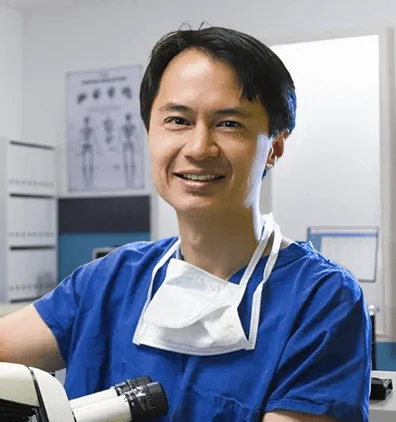

LASEK vs. LASIK
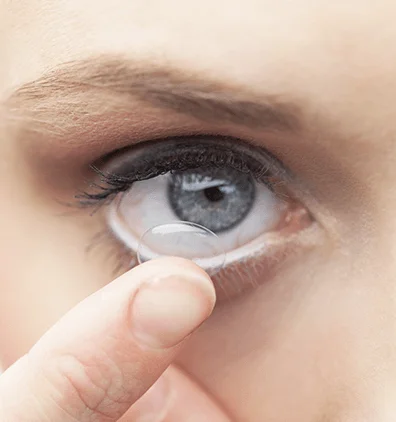

Ortho-K
Work while you sleep


Cross-linking (CXL)
Keratoconus treatment
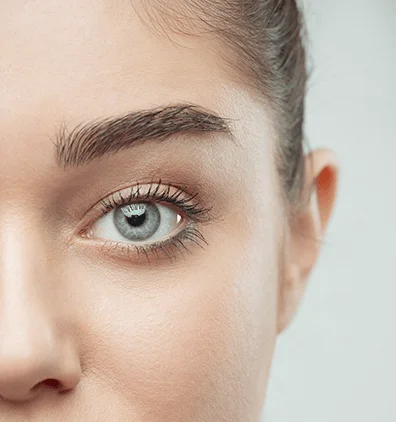

Eye Jewelry
Introducing the newest trend
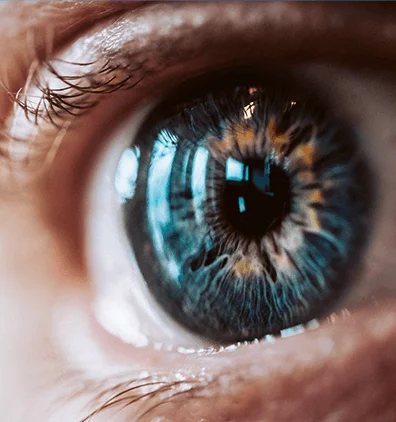

Corneal Tattoo
Ink to match your iris

Get Directions to Park Avenue LASEK
102 E 25th St, New York, NY 10010

